封面�
书名�
版权�
前言�
目录�
译者序�
第一部分 概述�
第1章 活动目录库套书的使用�
1.1 活动目录库套书的组成�
1.2 活动目录库套书的编写思想�
第2章 本书的内容�
第3章 微软参考资源的使用�
3.1 微软开发者网络�
3.1.1 MSDN和MSDN在线的比较�
3.1.2 订阅MSDN�
3.1.3 MSDN的使用�
3.1.4 使用MSDN在线�
3.2 Windows程序设计系列参考�
第4章 查找开发者所需的资源�
4.1 开发者支持�
4.2 在线资源�
4.3 关于学习的产品�
4.4 会议�
4.5 其他资源�
第二部分 指南、示例和编程参考�
第5章 ADSI函数和结构�
5.1 ADSI函数�
5.1.1 ADsBuildEnumerator函数�
5.1.2 ADsBuildVarArrayInt函数�
5.1.3 ADsBuildVarArrayStr函数�
5.1.4 ADsEncodeBinaryData函数�
5.1.5 ADsEnumerateNext函数�
5.1.6 ADsFreeEnumerator函数�
5.1.7 ADsGetLastError函数�
5.1.8 ADsGetObject函数�
5.1.9 ADsOpenObject函数�
5.1.10 ADsSetLastError函数�
5.1.11 AllocADsMem函数�
5.1.12 AllocADsStr函数�
5.1.13 FreeADsMem函数�
5.1.14 FreeADsStr函数�
5.1.15 ReallocADsMem函数�
5.1.16 ReallocADsStr函数�
5.1.17 废弃的ADSI函数�
5.2 ADSI结构�
5.2.1 ADS_ATTR_DEF结构�
5.2.2 ADS_ATTR_INFO结构�
5.2.3 ADS_BACKLINK结构�
5.2.4 ADS_CASEIGNORE_LIST结构�
5.2.5 ADS_CLASS_DEF结构�
5.2.6 ADS_DN_WITH_BINART结构�
5.2.7 ADS_DN_WITH_STRING结构�
5.2.8 ADS_EMAIL结构�
5.2.9 ADS_FAXNUMBER结构�
5.2.10 ADS_HOLD结构�
5.2.11 ADS_NETADDRESS结构�
5.2.12 ADS_NT_SECURITY_DESCRIPTOR结构�
5.2.13 ADS_OBJECT_INFO结构�
5.2.14 ADS_OCTET_LIST结构�
5.2.15 ADS_OCTET_STRING结构�
5.2.16 ADS_PATH结构�
5.2.17 ADS_POSTALADDRESS结构�
5.2.18 ADS_PROV_SPECIFIC结构�
5.2.19 ADS_REPLICAPOINTER结构�
5.2.20 ADS_SEARCH_COLUMN结构�
5.2.21 ADS_SEARCHPREF_INFO结构�
5.2.22 ADS_SORTKEY结构�
5.2 23 ADS_TIMESTAMP结构�
5.2.24 ADS_TYPEDNAME结构�
5.2.25 ADSVALUE结构�
第6章 枚举、数据类型和常量�
6.1 ADSI枚举�
6.1.1 ADS_ACEFLAG_ENUM枚举�
6.1.2 ADS_ACETYPE_ENUM枚举�
6.1.3 ADS_AUTHENTICATION_ENUM枚举�
6.1.4 ADS_CHASE_REFERRALS_ENUM枚举�
6.1.5 ADS_DEREFENUM枚举�
6.1.6 ADS_DISPLAY_ENUM枚举�
6.1.7 ADS_ESCAPE_MODE_ENUM枚举�
6.1.8 ADS_FLAGTYPE_ENUM枚举�
6.1.9 ADS_FORMAT_ENUM枚举�
6.1.10 ADS_GROUP_TYPE_ENUM枚举�
6.1.11 ADS_NAME_INITTYPE_ENUM枚举�
6.1.12 ADS_NAME_TYPE_ENUM枚举�
6.1.13 ADS_OPTION_ENUM枚举�
6.1.14 ADS_PREFERENCES_ENUM枚举�
6.1.15 ADS_PROPERTY_OPERATION_ENUM枚举�
6.1.16 ADS_RIGHTS_ENUM枚举�
6.1.17 ADS_SCOPEENUM枚举�
6.1.18 ADS_SD_CONTROL_ENUM枚举�
6.1.19 ADS_SD_REVISION_ENUM枚举�
6.1.20 ADS_SEARCHPREF_ENUM枚举�
6.1.21 ADS_SECURITY_INFO_ENUM枚举�
6.1.22 ADS_SETTYPE_ENUM枚举�
6.1.23 ADS_STATUSENUM枚举�
6.1.24 ADS_SYSTEMFLAG_ENUM枚举�
6.1.25 ADS_USER_FLAG_ENUM枚举�
6.1.26 ADSI_DIALECT_ENUM枚举�
6.1.27 ADSTYPEENUM枚举�
6.2 ADSI数据类型和常量�
6.2.1 ADSI简单数据类型�
6.2.2 ADSI常量�
第7章 关于ADSI接口�
7.1 ADSI接口的字典式列表�
7.2 接口的特性方法�
7.3 系统提供者的接口实现�
第8章 核心接口�
8.1 IAD接口�
8.1.1 IAD接口的特性方法�
8.1.2 IADs∷Get方法�
8.1.3 IADs∷GetEx方法�
8.1.4 IADs∷GetInfo方法�
8.1.5 IADs∷GetInfoEx方法�
8.1.6 IADs∷Put方法�
8.1.7 IADs:PutEx方法�
8.1.8 IADs∷SetInfo方法�
8.2 IADsContainer接口�
8.2.1 IADsContainer接口的特性方法�
8.2.2 IADsContainer∷CopyHere方法�
8.2.3 IADsContainer∷Create方法�
8.2.4 IADsContainer∷Delete方法�
8.2.5 IADsContainter∷get_NewEnum方法�
8.2.6 IADsContainer∷GetObject方法�
8.2.7 IADsContainer∷MoveHere方法�
8.3 IADsNamespaces接口�
8.4 IADsOpenDSObject接口�
第9章 架构接口�
9.1 IADsClass�
9.1.1 IADsClass接口的特性方法�
9.1.2 IADsClass∷Qualifiers方法�
9.2 IADsProperty接口�
9.2.1 IADsProperty接口的特性方法�
9.2.2 IADsProperty∷Qualifiers方法�
9.3 IADsSyntax接口�
第10章 特性高速缓存器接口�
10.1 IADsPropertyEntry接口�
10.2 IADsPropertyList接口�
10.2.1 IADsPropertyList接口的特性方法�
10.2.2 IADsPropertyList∷GetPropertyItem方法�
10.2.3 IADsPropertyList∷Item方法�
10.2.4 IADsPropertyList∷Next方法�
10.2.5 IADsPropertyList∷Purge-Propertylist方法�
10.2.6 IADsPropertyList∷PutPropertyItem方法�
10.2.7 IADsPropertyList∷Reset方法�
10.2.8 IADsPropertyList∷ResetPropertyItem方法�
10.2.9 IADsPropertyList∷Skip方法�
10.3 IADsPropertyValue接口�
10.3.1 IADsPropertyValue接口的特性方法�
10.3.2 IADsPropertyValue∷Clear方法�
10.4 IADsPropertyValue2接口�
10.4.1 IADsPropertyValue2∷GetObject-Property方法�
10.4.2 IADsPropertyValue2∷PutObject-Property方法�
第11章 持久性对象接口�
11.1 IADsCollection接口�
11.1.1 IADsCollection∷Add方法�
11.1.2 IADsCollection∷get NewEnum方法�
11.1.3 IADsCollection∷GetObject方法�
11.1.4 IADsCollection∷Remove方法�
11.2 IADsComputer接口�
11.3 IADsDomain接口�
11.4 IADsFileService接口�
11.5 IADsFileShare接口�
11.6 IADsGroup接口�
11.6.1 IADsGroup接口的特性方法�
11.6.2 IADsGroup∷Add方法�
11.6.3 IADsGroup∷IsMember方法�
11.6.4 IADsGroup∷Members方法�
11.6.5 IADsGroup∷Remove方法�
11.7 IADsLocality接口�
11.8 IADsMembers接口�
11.8.1 IADsMembers接口的特性方法�
11.8.2 IADsMembers∷get_NewEnum方法�
11.9 IADsO接口�
11.10 IADsOU接口�
11.11 IADsPrintJob接口�
11.12 IADsPrintQueue接口�
11.13 IADsService接口�
11.14 IADsUser接口�
11.14.1 IADsUser接口的特性方法�
11.14.2 IADsUser∷ChangePassword方法�
11.14.3 IADsUser∷Groups方法�
11.14.4 IADsUser∷SetPassword方法�
第12章 动态对象接口�
12.1 IADsComputerOperations接口�
12.1.1 IADsComputerOperations∷Shutdown方法�
12.1.2 IADsComputerOperations∷Status方法�
12.2 IADsFileServiceOperations接口�
12.2.1 IADsFileServiceOperations∷Resources方法�
12.2.2 IADsFileServiceOperations∷Sessions方法�
12.3 IADsPrintJobOperations接口�
12.3.1 IADsPrintJobOperations接口的特性方法�
12.3.2 IADsPrintJobOperations∷Pause方法�
12.3.3 IADsPrintJobOperations∷Resume方法�
12.4 IADsP rintQueueOperations接口�
12.4.1 IADsPrintQueueOperations接口的特性方法�
12.4.2 IADsPrintQueueOperations∷Pause方法�
12.4.3 IADsPrintQueueOperations∷PrintJobs方法�
12.4.4 IADsPrintQueueOperations∷Purge方法�
12.4.5 IADsPrintQueueOperations∷Resume方法�
12.5 IADsResource接口�
12.6 IADsServiceOperations接口�
12.6.1 IADsServiceOperations接口的特性方法�
12.6.2 IADsServiceOprations∷Continue方法�
12.6.3 IADsServiceOperations∷Pause方法�
12.6.4 IADsServiceOperations∷SetPassword方法�
12.6.5 IADsServiceOperations∷Start方法�
12.6.6 IADsServiceOperations∷Stop方法�
12.7 IADsSession接口�
第13章 安全接口�
13.1 IADsAccessControlEntry接口�
13.2 IADsAccessControlList接口�
13.2.1 IADsAccessControlList接口的特性方法�
13.2.2 IADsAccessControlList∷AddAce方法�
13.2.3 IADsAccessControlList∷Copy-AccessList方法�
13.2.4 IADsAccessControlList∷RemoveAce方法�
13.2.5 IADsAccessControlList∷get_NewEnum方法�
13.3 IADsSecurityDescriptor接口�
13.3.1 IADsSecurityDescriptor接口的特性方法�
13.3.2 IADsSecurityDescriptor∷Copy-SecurityDescriptor方法�
第14章 非自动化接口�
14.1 IdirectoryObject接口�
14.1.1 IDirectoryObject∷CreateDSObject方法�
14.1.2 IDirectoryObject∷DeleteDSObject方法�
14.1.3 IDirectoryObject∷GetObjectAttributes方法�
14.1.4 IDirectoryObject∷GetObject-Information方法�
14.1.5 IDirectoryObject∷SetObjectAttributes方法�
14.2 IDirectorySearch接口�
14.2.1 IDirectorySearch∷AbandonSearch方法�
14.2.2 IDirectorySearch∷CloseSearchHandle方法�
14.2.3 IDirectorySearch∷ExecuteSearch方法�
14.2.4 IDirectorySearch:FreeColumn方法�
14.2.5 IDirectorySearch∷GetColumn方法�
14.2.6 IDirectorySearch∷GetFirstRow方法�
14.2.7 IDirectorySearch∷GetNextColumnName方法�
14.2.8 IDirectorySearch∷GetNextRow方法�
14.2.9 IDirectorySearch∷GetPreviousRow方法�
14.2.10 IDirectorySearch∷SetSearch-Preference方法�
第15章 扩展接口�
15.1 IADsExtension接口�
15.2 IADsExtension∷PrivateGetlDsOfNames方法�
15.3 IADsExtension∷PrivateInvoke方法�
第16章 实用程序接口�
16.1 IADsDeleteOps接口�
16.2 IADsNameTranslate接口�
16.2.1 IADsNameTranslate接口的特性方法�
16.2.2 IADsNameTranslate∷Get方法�
16.2.3 IADsNameTranslate∷GetEx方法�
16.2.4 IADsNameTranslate∷Init方法�
16.2.5 IADsNameTranslate∷InitEx方法�
16.2.6 IADsNameTranslate∷Set方法�
16.2.7 IADsNameTranslate∷SetEx方法�
16.3 IADsObjectOptions接口�
16.3.1 IADsObjectOptions∷GetOption方法�
16.3.2 IADsObjectOptions∷SetOption方法�
16.4 IADsPathname接口�
16.4.1 IADsPathname接口的特性方法�
16.4.2 IADsPathname∷AddLeafElement方法�
16.4.3 IADsPathname∷CopyPath方法�
16.4.4 IADsPathname∷GetElement方法�
16.4.5 IADsPathname∷GetEscapedElement方法�
16.4.6 IADsPathname∷GetNumElement方法�
16.4.7 IADsPathname∷RemoveLeafElement方法�
16.4.8 IADsPathname∷Retrieve方法�
16.4.9 IADsPathname∷Set方法�
16.4.10 IADsPathname∷SetDisplayType方法�
16.5 IADsADSystemInfo接口�
16.5.1 IADsADSystemInfo接口的特性方法�
16.5.2 IADsADSystemInfo∷GetAnyDCName方法�
16.5.3 IADsADSystemInfo∷GetDCSiteName方法�
16.5.4 IADsADSystemInfo∷GetTrees方法�
16.5.5 IADsADSystemInfo∷RefreshSchemaCache方法�
16.6 IADsWinNTSystemInfo接口�
第17章 数据类型接口�
17.1 IADsAcl接口�
17.1.1 IADsAcl接口的特性方法�
17.1.2 IADsAcl∷CopyAcl方法�
17.2 IADsBackLink接口�
17.3 IADsCaseIgnoreList接口�
17.4 IADsDNWithBinary接口�
17.5 IADsDNWithString接口�
17.6 IADsEmail接口�
17.7 IADsFaxNumber接口�
17.8 IADsHold接口�
17.9 IADsLargeInteger接口�
17.10 IADsNetAddress接口�
17.11 IADsOctetList接口�
17.12 IADsPath接口�
17.13 IADsPostalAddress接口�
17.14 IADsReplicaPointer接口�
17.15 IADsTimestamp接口�
17.16 IADsTypedName接口�
第18章 ADSI系统提供者�
18.1 ADSI LDAP提供者�
18.1.1 LDAP ADsPath�
18.1.2 活动目录和LDAP之间的数据类型映射�
18.1.3 LDAP的ADSI对象�
18.1.4 LDAP语法对象�
18.1.5 LDAP用户对象�
18.2 ADSI WinNT提供者�
18.2.1 WinNT ADsPath�
18.2 2 WinNT的ADSI对象�
18.2.3 WinNT模式�
18.2.4 WinNT用户对象�
18.3 ADSI NDS提供者�
18.3.1 NDS ADsPath�
18.3.2 NDS的ADSI对象�
18.4 ADSI NWCOMPAT提供者�
18.4.1 NWCOMPAT ADsPath�
18.4.2 NWCOMPAT的ADSI对象�
18.5 ADSI路由器�
18.5.1 在路由器层实现的ADSI对象�
18.5.2 提供者支持的ADSI接口�
第19章 ADSI错误码�
19.1 普通的COM错误码�
19.2 普通的ADSI错误码�
19.3 ADSI的Win32错误码�
19.3.1 Win32错误码�
19.3.2 ADSI2.0的Win32错误码�
19.4 ADSI的LDAP错误码�
19.5 ADSI的扩展错误消息�
第三部分 附录�
附录A 术语表�
附录B 索引�

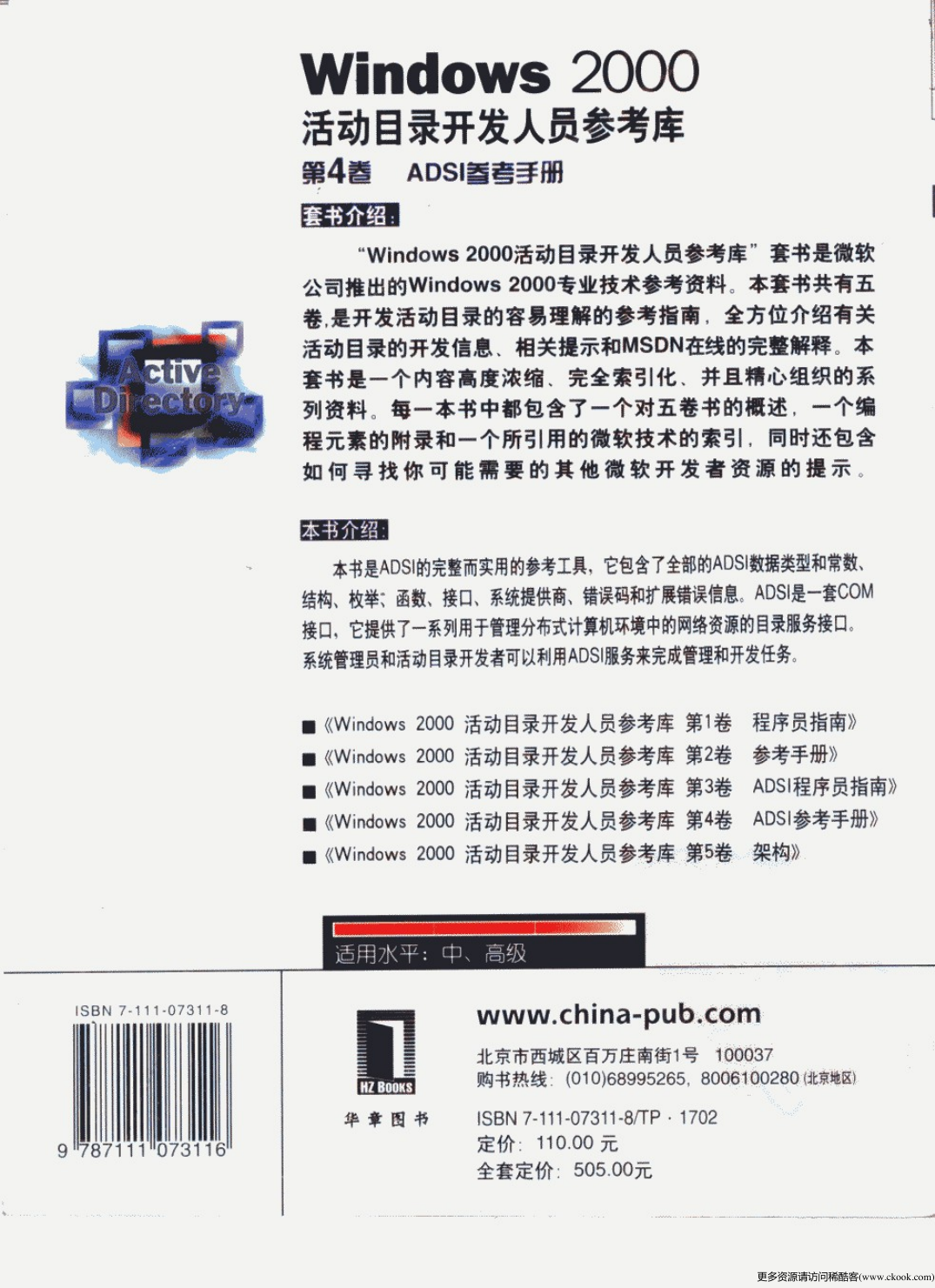

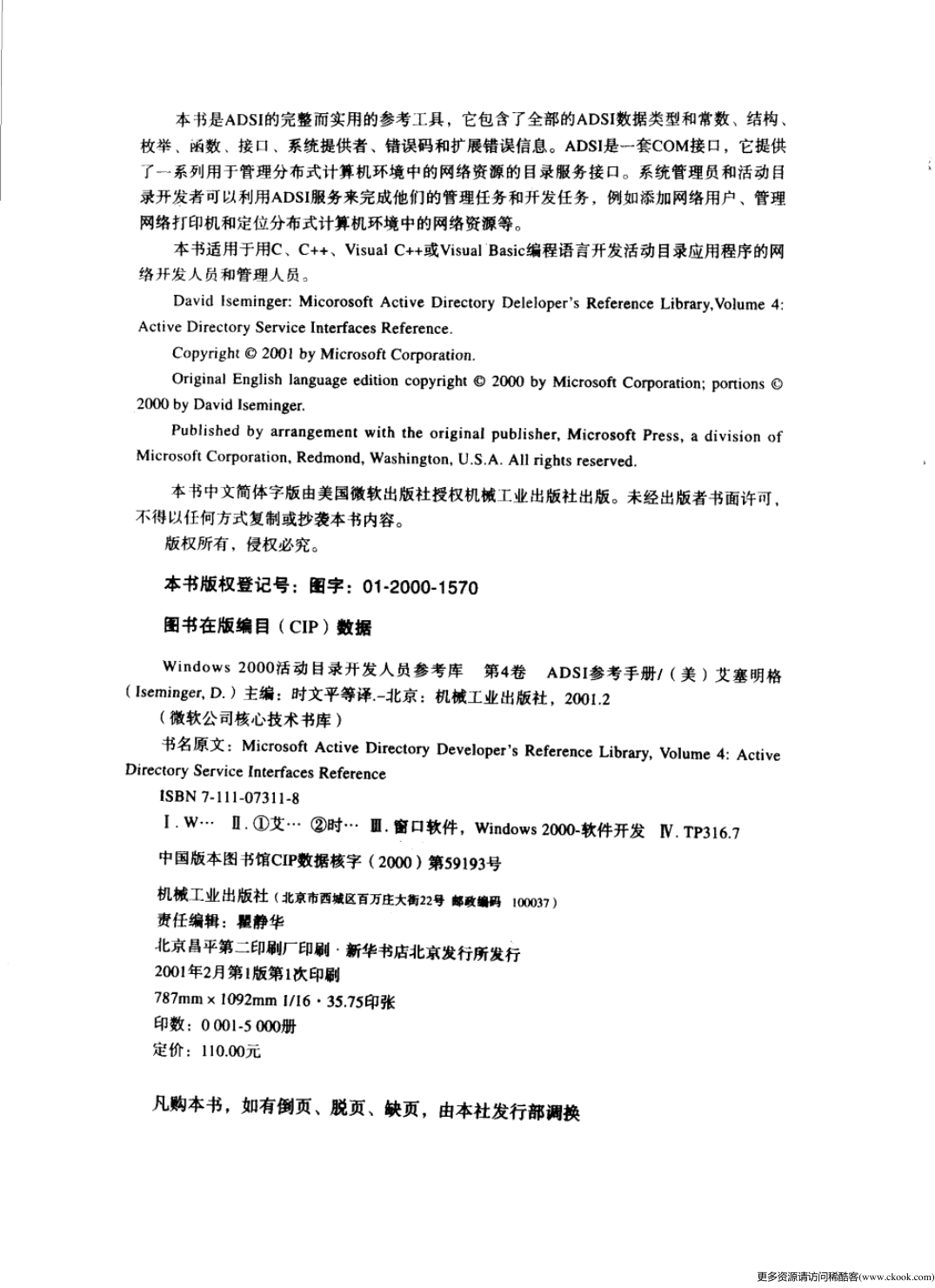
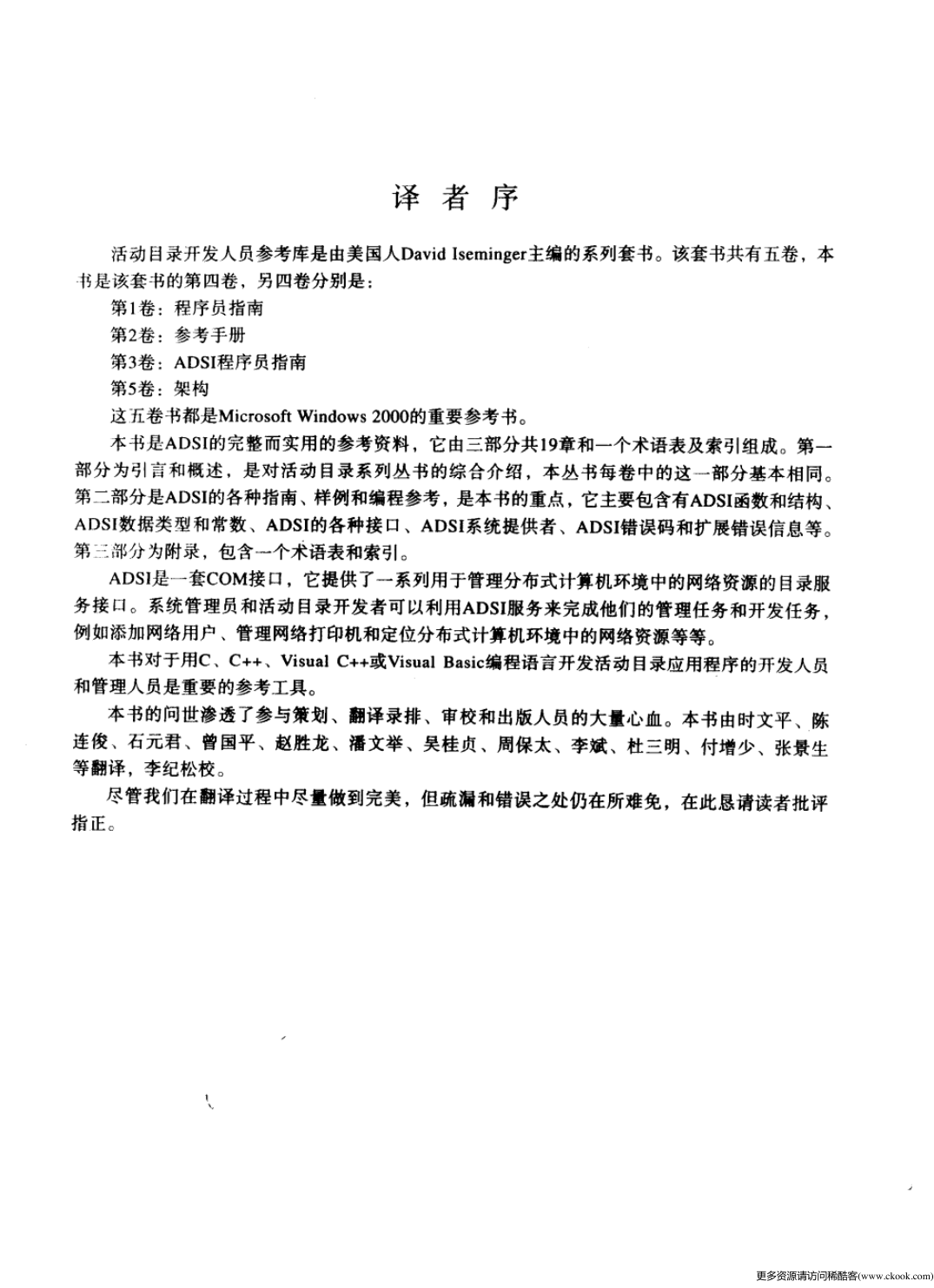
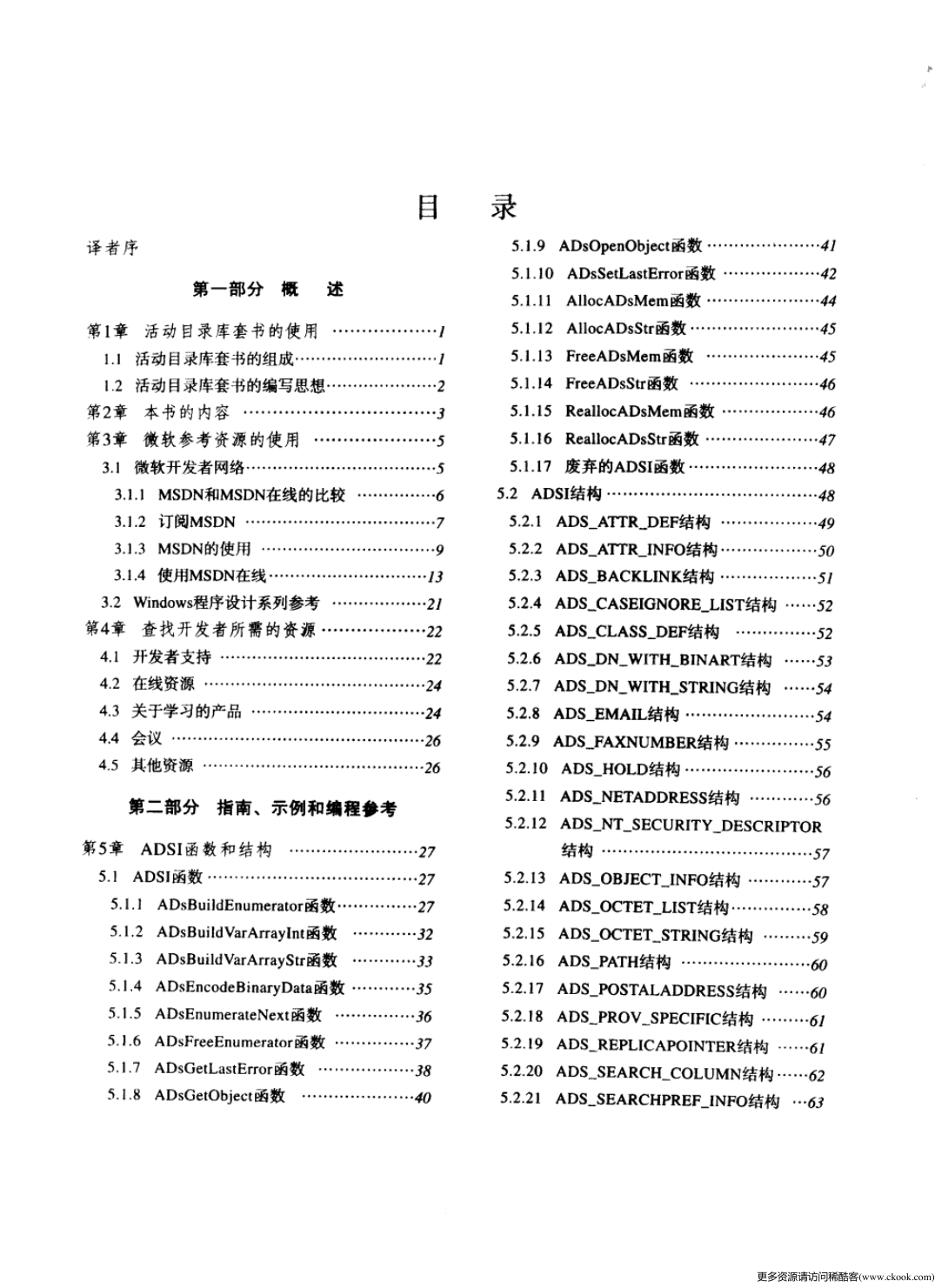

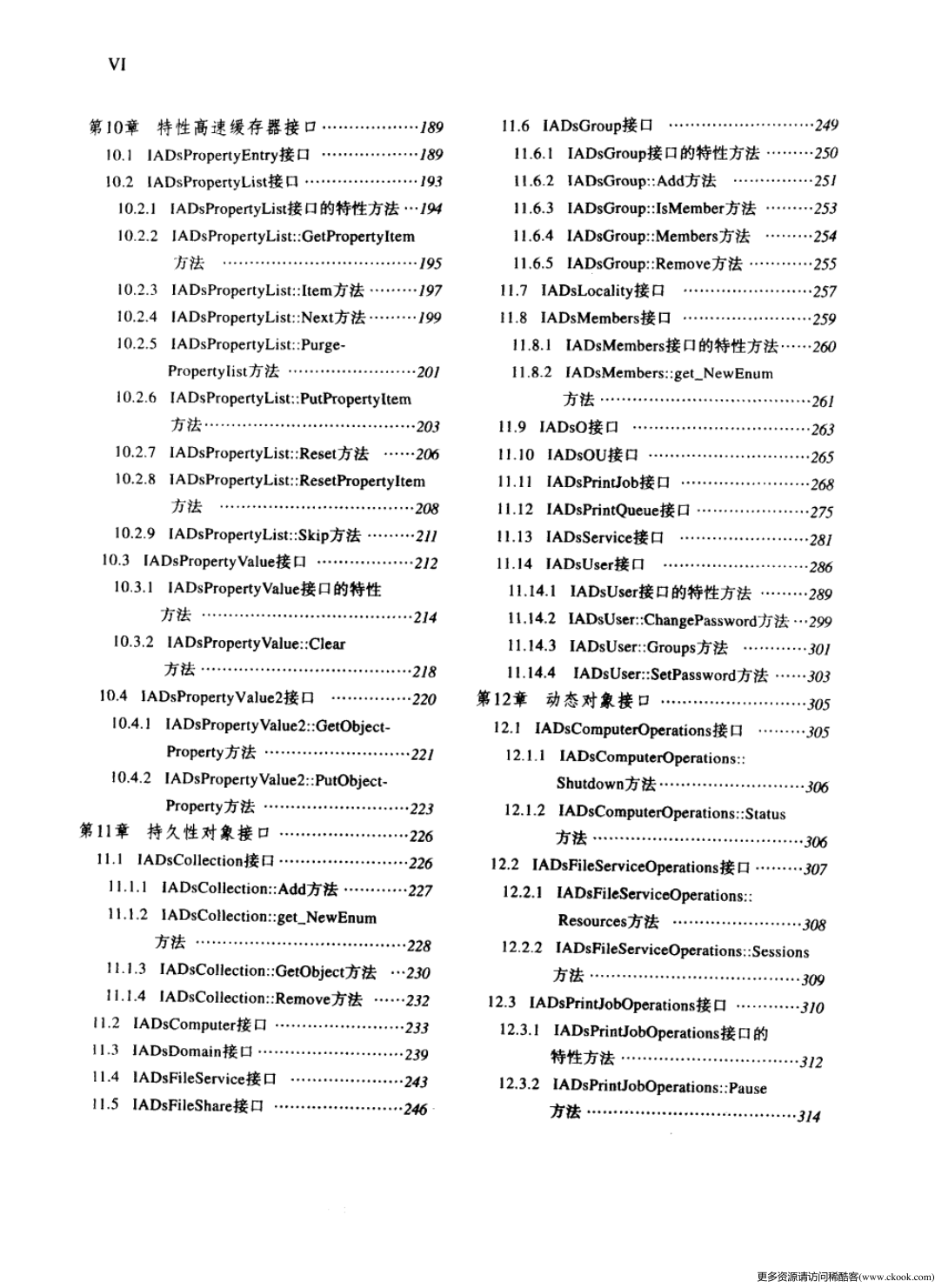








 2023年江西萍乡中考道德与法治真题及答案.doc
2023年江西萍乡中考道德与法治真题及答案.doc 2012年重庆南川中考生物真题及答案.doc
2012年重庆南川中考生物真题及答案.doc 2013年江西师范大学地理学综合及文艺理论基础考研真题.doc
2013年江西师范大学地理学综合及文艺理论基础考研真题.doc 2020年四川甘孜小升初语文真题及答案I卷.doc
2020年四川甘孜小升初语文真题及答案I卷.doc 2020年注册岩土工程师专业基础考试真题及答案.doc
2020年注册岩土工程师专业基础考试真题及答案.doc 2023-2024学年福建省厦门市九年级上学期数学月考试题及答案.doc
2023-2024学年福建省厦门市九年级上学期数学月考试题及答案.doc 2021-2022学年辽宁省沈阳市大东区九年级上学期语文期末试题及答案.doc
2021-2022学年辽宁省沈阳市大东区九年级上学期语文期末试题及答案.doc 2022-2023学年北京东城区初三第一学期物理期末试卷及答案.doc
2022-2023学年北京东城区初三第一学期物理期末试卷及答案.doc 2018上半年江西教师资格初中地理学科知识与教学能力真题及答案.doc
2018上半年江西教师资格初中地理学科知识与教学能力真题及答案.doc 2012年河北国家公务员申论考试真题及答案-省级.doc
2012年河北国家公务员申论考试真题及答案-省级.doc 2020-2021学年江苏省扬州市江都区邵樊片九年级上学期数学第一次质量检测试题及答案.doc
2020-2021学年江苏省扬州市江都区邵樊片九年级上学期数学第一次质量检测试题及答案.doc 2022下半年黑龙江教师资格证中学综合素质真题及答案.doc
2022下半年黑龙江教师资格证中学综合素质真题及答案.doc